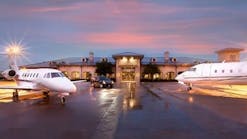The current explosion of private companies investing in the space sector has changed the paradigm for space travel and exploration at a rapid pace. It has also provided an entrepreneurial model to infuse dollars into the emerging urban air mobility market, or UAM.
In fact, NASA’s Aeronautics Research Mission Directorate (ARMD) is expanding its research on how to integrate unmanned air vehicles into the national airspace to include new work on UAM. What, exactly, is UAM? According to the NASA website, “UAM is a safe and efficient system for air passenger and cargo transportation within an urban area, inclusive of small package delivery and other urban Unmanned Aerial System (UAS) services, which supports a mix of onboard/ground-piloted and increasingly autonomous operations.”
In November 2017, the space agency signed an agreement with Uber to help develop an air traffic control system for the ride-share giant’s flying car project, called Uber Elevate. While not investing in vehicle developers, Uber has unveiled its vision and an aggressive plan for the urban air transportation of the future where electric air taxis will maximize the use of vertical and horizontal airspace in crowded cities as part of an on-demand network.
As technology propels aviation into the future, it may also change the paradigm for how airports conduct business, especially in terms of facilities, fees and services. While FBOs in the U.S. typically bundle their services, the expansion of general aviation aircraft operations to include electric air taxis may effect changes in the current business model, such as in the area of hangar and ramp, fuel and other facility requirements and pricing. Clearly, UAM raises serious questions about related economic, regulatory and social issues.
Transport Solution for Tomorrow
Most recently, the venture capitalist arm of JetBlue Airways provided an undisclosed amount of funding to California-based Joby Aviation toward certifying its five-seat electric vertical-take-off-and-landing (eVTOL) aircraft. Joining the ranks of companies such as Toyota and Intel, JetBlue’s infusion brings the amount raised by the startup to an impressive $130 million.
Also working to make UAM a reality, aerospace giants such as Boeing and Airbus are expanding their air mobility efforts, believing the solution to increased urbanization and congestion is found in the sky. For example, Airbus has embarked on several UAM projects, ranging from helicopter rides to shared flying vehicles to delivery drones. It has already carried out a successful trial of its helicopter ride-hailing service Voom in São Paulo, with the goal of easing traffic congestion by making helicopter travel more affordable and accessible.
Airbus teams from Silicon Valley to Europe and Asia are also working to create brand new vehicles such as CityAirbus, an eVTOL for up to four passengers and Vahana, designed for individual travelers or cargo transport. In Singapore, the company is participating in the Skyways project to test a parcel transport system using autonomous drones.
Could it be that, much sooner than later, passengers will be able to book electric air taxi flights using mobile app technology and have the nearest vehicle sent directly to their location? Uber says it hopes to begin flying its aerial taxis – basically, small planes with wing-mounted propellers and vertical takeoff capabilities – by 2020. The company has also announced three test sites, including Los Angeles, Dallas and Dubai.
What does this mean for airports, and what are the challenges to enabling UAM?
UAM Challenges
A primary challenge is how to safely integrate electric air taxis into the national airspace system. NASA hopes to use its work on integrating both large- and small-size drones to establish how to make using autonomous vehicles, electric propulsion and high density airspace operations in the urban environment safe and economically viable. For example, Airbus hopes to eventually make Vahana and CityAirbus autonomous to help facilitate safe operation in busier airspace, which makes the development of sense-and-avoid technology paramount.
One of the most important certification concerns is whether the vehicles are safe to fly and land in crowded urban areas, especially during emergencies. The new technology must also meet all requirements for aviation safety and performance. For example, the eVOTL requires fast charging and higher density battery packs than are currently available for electrical vehicles. While the technology is being readily developed, it must still be proven safe.
Airports must also address issues of operational infrastructure, such as the development of dedicated landing pads, maintenance facilities and charging stations. Can electric air taxis be accommodated at existing Part 145 repair stations? Does the airport have the capacity to accommodate the frequency and density of projected UAM operations? Are new FAA regulations, policies and procedures needed to ensure safe and efficient urban flight?
At an even more fundamental level, one wonders whether the FAA will classify the operators of electric air taxis as pilots, and not drivers. In light of the global pilot shortage, airport operators must consider how the competition for limited resources will affect the aviation industry as a whole. Also, in terms of preserving airport safety and security, it must be determined who will manage and take responsibility and jurisdiction for passenger screening beyond the airport’s perimeter fence, and at what cost.
Finally, public acceptance of UAM operations presents a major challenge. While it is important to demonstrate safe operations, it is also critical to address any community noise or privacy concerns. Proponents say UAM will ease congestion on city streets, reduce noise and pollution, and improve the urban environment. However, developers of this new technology, as well as leaders of government, must consider how UAM operations will fit within the community landscape.
Collaboration is Key
Collaboration among aviation industry, business, civic and community stakeholders is needed to establish the feasibility for high density airspace operations in the urban environment, develop the infrastructure to make UAM a reality and address the concerns of the community.
In addition to engineering and manufacturing challenges, new air vehicles require certification, air space regulation, air traffic management systems, charging stations and landing pads, not to mention trained pilots. The public also needs to be ready and receptive to traveling through congested cities in the air, rather than on the ground.
As technology moves faster than policy, the research agenda must include how much potential demand there is for UAM and how to best deploy resources to meet that demand. The current administration has made it clear that the private sector will play a major role in addressing these issues.
Curt Castagna, president and CEO of Aeroplex/Aerolease Group, is a member of the Los Angeles County Airport Commission, president of the Van Nuys and Long Beach Airport Associations, and a board member of the National Air Transportation Association. A certified private and instrument-rated pilot, he has instructed courses in aviation administration at Cal State Los Angeles for over two decades.



